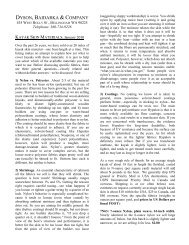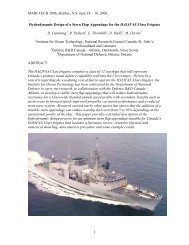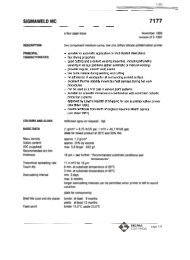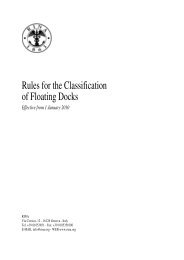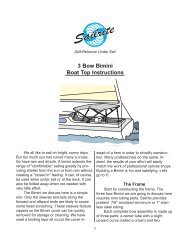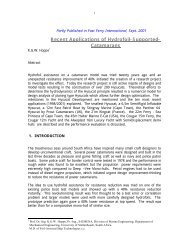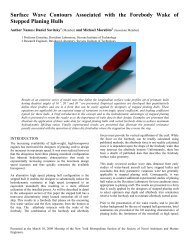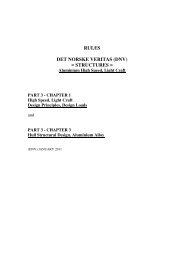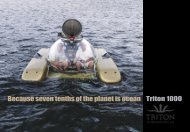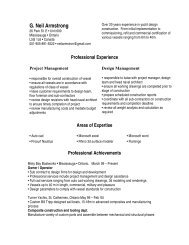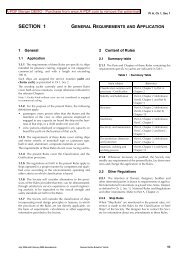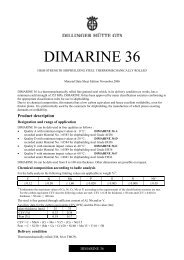CD03 - Issue #74: Designer / Builder Paul Bieker--Process Control ...
CD03 - Issue #74: Designer / Builder Paul Bieker--Process Control ...
CD03 - Issue #74: Designer / Builder Paul Bieker--Process Control ...
You also want an ePaper? Increase the reach of your titles
YUMPU automatically turns print PDFs into web optimized ePapers that Google loves.
same, hut I took volume out of the topsidesby making the sides more vertical:the bow is narrower up high and theracks stick out relatively more."Although maximum beam is limited to6' (1.8m) in 14s, rack widths ultimatelyface practical limitations. In lulls, crewscloser to the centerline might simplybend their knees to reduce rightingmoment by 20% and keep the boat fromcapsizing to weather. With wide racks,the same crew may need to jump backinto a boat, then jump out again in aputt. Racks too wide would exhaust thecrew in the puffy conditions in which14s often sail.With racks now supporting the backof the boat structurally, sailors reallyonly needed a place to hang the rudderand "corner brackets" to keep the waterout during tacks, so <strong>Bieker</strong> developeda rudder pod and eliminated the transom.To augment control under big asymmetricalchutes. <strong>Bieker</strong>'s pod ties into thehull but extends the rudder mountingwell aft, lengthening the blade's leverarm on the centerboard, as well as providingmore room for the crew tomove aft to keep the bow up. Aroundthe top and bottom of the ruddertrunk, <strong>Bieker</strong> attaches wide carbonflanges that provide enormous stiffnessand strength with little weight. "Before 1came up with that configuration, peoplewere just throwing a lot of materialat the problem, but I found you canmake these flanges really light andstrong," he says. The flanges are quitethick on the nose to carry a long pintlepin that passes through them and acomposite gudgeon tube bonded to thepod and spanning the flanges.All the most recent World championshave been kept on track with <strong>Bieker</strong>designeddaggerboards and rudders.The tapered laminar-flow foils featurehollowed tail sections and almostknife-sharptrailing edges. "My theoryis that you spend 90 percent of yourtime going in a straight line." explains<strong>Bieker</strong>, "so the foils are usually verylightly loaded. It's a laminar-flow section,but it pencils out over a prettygood range of angles of attack. Yourmaximum lift coefficient may be off 10to 15 percent less than a standardNACA0012 section, but the rest of thetime it reduces drag significantly. Atspeed, when other sections suffer separationand get unpredictable due to theamount of curvature forward, thesefoils are rock solid; the faster you go,the better they are. Because of theirshape and the fact that they're builtfrom computer-machined tooling,they're the only 14 foils I know of thatdon't hum at speed." Empirical evidencetells him the foils are maintaininglaminar flow at least over the firsttwo-thirds to three-quarters of the sections.Painstaking construction (see thesidebar on page 82) is required to keepthe close tolerances and sharp tail, but<strong>Bieker</strong> thinks it's well worth the trouble."Ideally, I'd bring all foil trailingedges to zero." he notes.The last Worlds were won by a<strong>Bieker</strong> 3 with a new hydrofoil-rudder."I became interested in it because Iwanted to make the water think thatthe boat was longer—by putting liftinto the rudder." Calculations indicatedthat added drag from a T-foil operatingaway from the free surface wouldexceed the reduction of drag on thepartially lifted hull. <strong>Bieker</strong>, however,figured that a foil raised nearer the freesurface might gain an advantage fromthe angle of attack of the water flowingup from the transom. Foils create a lot72 PROFESSIONAL BOATBUILDER



